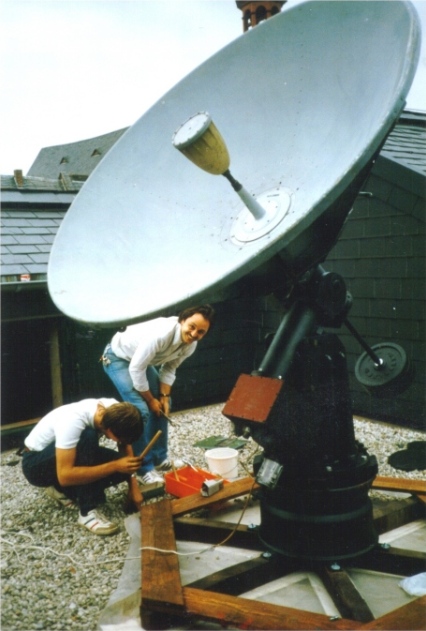Susanne Schell, Michael Hutzler, Detlev Köpp
We were given a 1.75 m parabolic mirror with dipole, a receiver and a data recorder by the father of one of our classmates who works at the Max-Planck-Institute for Radio Astronomy in Bonn. Therefore, we decided to build a small radio telescope. Due to its relatively low sensitivity, we decided to focus on solar observations at 2.86 GHz.
Initially, we looked into celestial mechanics and found that an equatorial mount for the parabolic mirror would be most favourable. This requires one axis (hour axis) to be mounted parallel to the earth's axis of rotation (ca. 50.5° tilt to the horizon in Bad Münstereifel). The other axis (declination axis) is perpendicular to the hour axis and it supports the parabolic reflector and the counter weight. This mounting arrangement allows the compensation of the earth's rotation with a slow engine. Next, we planned the construction of an equatorial mount. Finding a suitable engine turned out to be a major challenge, which was only resolved when we were given an old engine, a rusty transmission and parts of an old equatorial mount by Radio Telescope Stockert. The difficult transport of these heavy parts was followed by the restoration of the transmission, which involved bridging of a broken clutch, removal of rust from the ball bearings and ordering of two new custom cogs. Later we planned, ordered and stabilized (by welding) the adapter for fixing the mirror on the equatorial mount. To prevent collisions of the parabolic mirror with the ground, we welded U-shapes onto an old truck rim, so that the rim could be used as support. We turned barbell weights into a counterweight for the parabolic mirror. Then we calculated the weight of the entire radio telescope and found that we needed a stand to distribute the weight. The stand had to be strong enough to carry the telescope including wind load, but without adding too much additional weight. After basic estimates we constructed a wooden stand to carry the rim support of the telescope. Finally, we had to identify a location for the radio telescope. After checking with the relevant state authorities for preservation of historic buildings and a structural engineer, we assembled the telescope on the roof of our school. Moving the large mirror onto the roof was particularly challenging and required beams and ropes. At the time of writing, we had initial measurements that were affected by radar and thermal emissions from walls. Work towards optimal results as well as the computer control for solar tracking of the parabolic mirror are ongoing.
